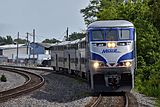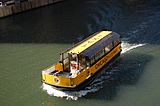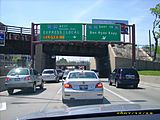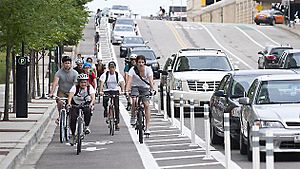Transportation in Chicago facts for kids
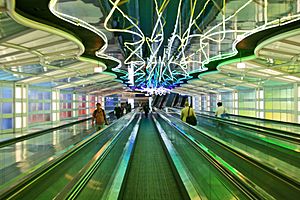
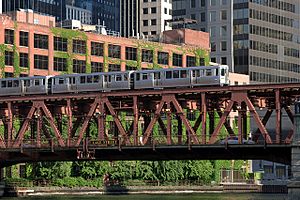
Chicago, Illinois, is the third-largest city in the United States. It is a very important place for travel and shipping around the world. Chicago has two big airports, many highways, and different types of train lines. It is also the main hub for passenger trains like Amtrak and for cargo trains in North America.
The Chicago Department of Transportation takes care of roads and public transport within the city. The Regional Transportation Authority (RTA) helps manage public transport in the wider Chicago area. The RTA supports three main groups: the Chicago Transit Authority (CTA), Metra, and Pace. These groups help people get around using buses and trains. The Chicago Department of Aviation runs the city's airports.
Contents
Chicago's Busy Airports
Chicago has some of the busiest airports in the world! They connect the city to places all over the globe.
O'Hare International Airport
O'Hare International Airport is one of the busiest airports in the world. It handles many flights to places both inside and outside the United States. O'Hare is a major hub for United Airlines and American Airlines. This means these airlines use O'Hare as a central point for many of their flights. The airport is currently being expanded to handle even more travelers.
Midway International Airport
Midway International Airport mainly serves flights to places within the U.S., plus Toronto in Canada and some cities in Mexico. It's a big focus city for Southwest Airlines.
Other Airports Near Chicago
There are also other smaller airports in the Chicago area:
- Gary/Chicago International Airport in Gary, Indiana, is about 25 miles southeast of downtown Chicago. It's sometimes called the "third airport" for the Chicago area. It mainly handles cargo flights and private planes, but it's working to attract passenger airlines.
- Chicago Rockford International Airport in Rockford also has passenger flights to many U.S. cities and cargo flights. It aims to serve people from Chicago's western suburbs.
- A public heliport called Chicago Vertiport opened in 2015. It's a place where helicopters can land and take off.
Some people in Chicago's northern suburbs also use Milwaukee Mitchell International Airport in Milwaukee to avoid busy Chicago airports. Also, South Bend International Airport in South Bend, Indiana is connected to downtown Chicago by a train line called the South Shore Line.
Suburban Airports
Several smaller airports are located in the suburbs around Chicago. These are often used for private planes or smaller commercial flights.
| Name | Location |
| Aurora Municipal Airport | Sugar Grove, Illinois |
| Clow International Airport | Bolingbrook, Illinois |
| Chicago Executive Airport | Wheeling, Illinois |
| DuPage Airport | West Chicago, Illinois |
| Lewis University Airport | Romeoville, Illinois |
| Schaumburg Regional Airport | Schaumburg, Illinois |
| Waukegan Regional Airport | Waukegan, Illinois |
Cycling Around Chicago
Chicago has a large network of paths and lanes for bicycles, stretching over 290 miles. These include shared paths, special cycle tracks, and bike lanes. You can ride bikes on almost all Chicago roads, except for major highways.
A bicycle sharing system called Divvy lets you rent bikes from many stations across Chicago, Evanston, and Oak Park. There are thousands of bikes available for public use.
You can also find Pedicabs for hire in busy areas, especially during events. These are like bicycle taxis. If you want to rent a bike for a day, there are many rental shops, especially near the lakefront in the Loop area.
Bikes on Public Transport
It's often possible to take your bike with you on Chicago's public transport:
- CTA Buses: Buses have racks on the front for bikes.
- CTA Trains ('L'): You can bring bikes on trains during off-peak hours (not during busy morning and evening rush hours). On weekends and holidays, bikes are allowed all day, except during special events.
- Metra Trains: Bikes are allowed on Metra commuter trains during off-peak times and in the opposite direction of rush hour travel.
- South Shore Line: This train line allows bikes on certain trains as part of a special program, mainly outside of winter.
- Water Taxis: Bikes are allowed on water taxis during off-peak and weekend hours.
Chicago's Public Transit Systems
Chicago has a huge public transportation system that helps millions of people get around every day.
Chicago Transit Authority (CTA)
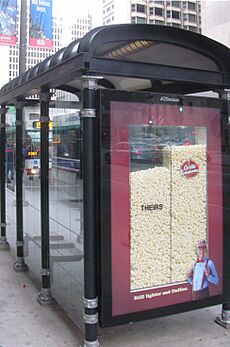
The Chicago Transit Authority, or CTA, is one of the biggest public transport systems in the United States. It serves the City of Chicago and 40 nearby suburbs. The CTA runs 24 hours a day, and about 1.6 million rides are taken on CTA buses and trains every weekday.
The CTA has about 2,000 buses that travel on over 150 routes. These buses make about 1 million passenger trips daily. The city's rapid transit system is known as the "Chicago 'L'" (short for "elevated"). It has 1,190 train cars that run on eight different routes. CTA trains make about 745,000 trips each day and stop at 144 stations.
Chicago is one of the few U.S. cities with train service to two major airports:
- The Blue Line connects downtown to O'Hare International Airport in about 40 minutes.
- The Orange Line takes you from downtown to Midway Airport in about 25 minutes.
Bus Services
Suburban Buses (Pace)
Pace is another public transport group that mainly runs bus services in the suburbs around Chicago. Pace also has some routes that go into Chicago. Pace buses help many people in the wider Chicago area get around, especially in places not served by the 'L' trains.
Inter-city Buses
Many bus companies offer rides from Chicago to other cities in Illinois and across the United States. Most of these buses leave from the Greyhound Lines terminal. Companies like Greyhound connect Chicago to major cities like Indianapolis, Detroit, Milwaukee, and St. Louis.
Other companies, like Megabus, use different stops, often near Union Station. They also connect Chicago to many cities. Some bus companies specialize in connecting Chicago with cities in Texas and Mexico.
Rail Services
Commuter Trains (Metra)

Metra is Chicago's commuter railroad. It has eleven lines that serve over 200 stations in Chicago and its surrounding counties. Unlike the 'L' trains, Metra fares depend on how far you travel. Metra trains are known for being fast and reliable, especially during busy morning and evening rush hours.
Metra trains arrive at four different stations in downtown Chicago:
- Richard B. Ogilvie Transportation Center
- Union Station (also where Amtrak trains arrive)
- LaSalle Street Station
- Millennium Station
The Metra Electric District line is Chicago's oldest commuter train, running since 1856. It shares its tracks with the South Shore Line, which is a train that connects Chicago to South Bend, Indiana.
Inter-city Trains (Amtrak)
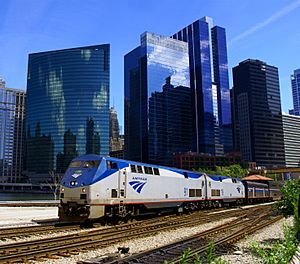
Amtrak is the national passenger rail service in the U.S. It owns and operates Union Station, which is one of the biggest train hubs in the country. Many of Amtrak's long-distance routes start or end in Chicago. If you're traveling through Chicago on Amtrak, you usually have to change trains at Union Station to reach your final destination. Union Station also connects to Metra and the 'L' trains.
Chicago Express Loop
The Chicago Express Loop is a planned high-speed train line. It aims to connect downtown Chicago (the Loop) to O'Hare Airport very quickly.
Tourist Trolleys
In the past, the City of Chicago offered free "tourist trolleys" that looked like old streetcars but were actually buses. They served popular tourist spots like the Museum Campus and Navy Pier. This free service stopped in 2009.
There are also private companies, like the Chicago Trolley Company, that offer guided tours on similar-looking buses. These tours charge a fare.
Public Transportation Statistics
On average, people in Chicago spend about 86 minutes each day traveling to and from work using public transport. About 28% of public transit riders travel for more than 2 hours daily. The average wait time at a stop or station is 15 minutes, and about 21% of riders wait for over 20 minutes. The average trip distance is about 6.3 miles.
Roads and Expressways
Chicago has a large network of roads and expressways (highways) that help people drive in and out of the city.
Taxis
Chicago taxicabs are run by private companies but are licensed by the city. In 2012, new rules were put in place for taxis. These rules increased the starting fare, made sure taxis had credit card readers and GPS, and set limits on how old a taxi could be.
Chicago has also worked to increase the number of taxis that use hybrid or alternative fuels. Now, over 74% of the city's taxis are more environmentally friendly.
Water Transportation
Chicago's waterways are very important for shipping, passenger ferries, and fun boating activities. The main waterways include Lake Michigan, the Chicago River, the Calumet River, and the Chicago Sanitary and Ship Canal. These waterways connect the Great Lakes to the Mississippi River, which was a big reason why Chicago was founded in the first place!
Commercial Shipping
The Port of Chicago handles commercial shipping traffic. It used to be centered on the Chicago River but has since moved to the Lake Calumet area.
Passenger Ferry Service
Passenger ferry services, also known as water taxis, operate on set routes with schedules.
- Shoreline Sightseeing offers water taxi service along the Chicago River, with stops at Navy Pier, Michigan Avenue, and Adams Street. They also have a route from Navy Pier to the Museum Campus.
- Wendella Boats operates the Chicago Water Taxi. It also offers scheduled service along the Chicago River, with stops at Michigan Avenue, Clark Street, Madison Street (near train stations), Chicago Avenue, North Avenue, and Ping Tom Park in Chinatown.
Recreational Boating
Many people enjoy boating for fun in Chicago. This includes tour boats, sailboats, powerboats, and even canoes and kayaks. There are many private and commercial places to dock boats. The Chicago Park District also runs a large harbor system on Lake Michigan for storing recreational boats during the warmer months. It can hold 6,000 boats, making it the largest system of its kind in the country. You can also rent boats on the Chicago River and in the Lake Michigan harbors.
|




